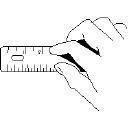 Measurement
Tips For The Exact Gardener
Measurement
Tips For The Exact Gardener
 Measurement
Tips For The Exact Gardener
Measurement
Tips For The Exact Gardener
Math is indeed an intricate part of gardening. Sometimes a rough estimate will do, and occasionally you need to be quite exact. Were you making chocolate milk, you could add two teaspoons of chocolate, more or less, and your milk would taste fine. If you were taking heart medicine, you would certainly have to be exact with the measurements. Likewise, a reasonable estimate of the square footage of your lawn is satisfactory. However, concentrated fertilizers or pesticides must be measured with the greatest of care.
Square footage is the measure of an area, usually derived by multiplying length by width to obtain “square footage”. For example, if your front yard is 80 feet long by 40 feet wide, then your square footage is 3200 square feet. If you are over seeding with grass seed at the rate of 3 pounds per 1000 square feet then you will need 9.6 pounds of grass, so buy a 10 pound bag (3.2 thousand square feet x 3 pounds = 9.6 pounds).
This may seem a bit elementary, but it amazing how many people will say they have “about a ¼ of an acre”. When made to do the math they often find they have much less area. A ¼ of an acre is 11,000 square feet and would require about 25 pounds of seed for over seeding. Applying this amount to 3200 square feet would not only be a waste of money, but the lawn would suffer from disease problems because the turf would be too dense. In our trade, we refer to 1000 square feet as an “m”. A “5m” bag of fertilizer covers 5000 square feet.
Most areas are not square and may require a little higher math. One method is averaging. An example would be a pie shaped area which is 100 feet long on average, with the broadest point being 60 feet wide and the narrowest point being 20 feet wide. We would add 60 & 20; divide by 2; and get an average width of 40 feet. The 40 feet would be multiplied by 100 feet. Roughly, your square footage would be 4000 square feet or “4m”. Speaking of roughly, a full “pace” by the average sized person is pretty close to 3 feet. An area 10 paces by 20 paces would be about 30 feet by 60 feet, or 1800 square feet.
Cubic footage is height by width by length. If you water garden has an estimated length of 8 feet, an estimated width of 6 feet, and an average depth of 18” (1-1/2 feet), then your cubic footage is 72 cubic feet (8' x 6' x 1-1/2'). There are 7.48 gallons of water in a cubic foot. By multiplying 72 cubic feet by 7.48 gallons, you will know your pond contains approximately 538 gallons.
If you are building a rock border for your flower beds which is 46 feet long, averages 8 inches (.67 feet) tall, and is 12 inches tall, then you will need 30.82 cubic feet of rock (46 foot x .67 foot x 1 foot). We know that our pallets of stone are about 28 cubic feet per pallet, so start with one pallet. At $200 per pallet, it is important to get a measurement before you start a project so you will know the cost.
Mulch is a “biggie” in the field of measurement. A cubic yard is 27 cubic feet. If you want to apply your mulch at a depth of 2 inches, you would need to know that a cubic foot will cover 6 square feet at a 2 inch depth. Thus a cubic yard would cover 162 square feet at a 2 inch depth. For quick reference, a 2 cubic foot bag of mulch covers 24 square feet at 1 inch; 18 square feet at 1-1/2 inches; or 12 square feet at 2 inches deep.
Cubic yards apply to top soil as well. Let’s say you decide to add 4 inches of top soil to your lawn, which is 6000 square feet. A cubic yard will cover 81 square feet at 4 inches (cubic foot at 4” covers 3 square feet; 3 x 27 = 81). 6000 square feet divided by 81 square feet equals 74 cubic yards, or about 8 large dump trucks of soil. Were you ready for that when you planned the project?
What about a "bushel"? A bushel consists of 4 "pecks" and a "peck" is 2 gallons. So a bushel is 8 gallons and has slighty more volume than a cubic foot. Now that's a "passle" of apples!
I won’t go into “pie are square” and “pie are round”, the measurements of area and circumference. I will say that these measurements are frequently used in horticulture. For a rough estimate of circumference, simply multiply the diameter by 3. Hope this is not too much of a “snoozer”. I am reminded of my Grandma, who made the best pancakes in the world. I finally asked her for the recipe. She would answer, “About a cup of flour, a pinch of baking powder…” So much for accuracy. Somehow, I think my Grandma added something to those pancakes that couldn’t be bought at the store. Until next week.
Andy Lynn